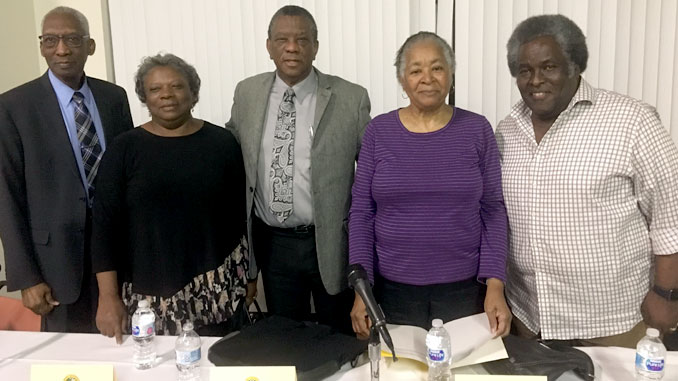
By Victoria Clark
Doretha Smith walked around the lobby of the sixth floor as she acknowledged old pictures of herself and her friends. As she walked forward and spoke to people nearby her, others started to realize she was the main event. An audience gathered around Smith as she reminisced about her time in the Civil Rights Movement.
“People are always saying to us you’re a hero,” Smith said as she shook her finger lightly to say no, “Our parents are.”
A public exhibit called “Children and Teenagers: Contributions to the Civil Rights Movement in Louisiana” opened Feb. 28, 2018, at the Xavier University Library. It displays the historic role Louisiana’s children had in the Civil Rights Movement. A panel discussion including Civil Rights Activists Doretha Smith, Warren Ray, Leona Tate, Kenard Ferdinand, and Raphael Cassimere Jr. took place to have people from the movement explain the hard struggle that has brought change to the country.
The Civil Rights Movement is often only considered as an adult-led movement. Some of the more popular activists like Martin Luther King, Malcolm X, Assata Shakur, etc. are the most talked-about names. It is very rare that people learn about the teenagers and children that were involved in the movement, the panelists said.
“This was a time, and this was a moment that was being fueled by students. I think it was just a calling for me,” Raphael Cassimere Jr. said on why he joined the Civil Rights Movement in New Orleans.
McDonogh No. 19, an Elementary School located on Tricou Street and Douglas Street in New Orleans was known as an all-White school. The school was integrated in 1960 by three Black girls. One of those girls was Leona Tate.
“Being six years old, I didn’t know exactly what was going on. I knew I was doing something different.,” Tate said. “I knew something was going to happen. I remember parents pulled the White students out and that lasted for about half a year,” Tate recalled. While people like Leona Tate and Ruby Bridges integrated schools at an extremely young age, Kenard Ferdinand was a teenager who was looking for a change for his people.
“We grew up where everything was questioned. It seems so simple this equality thing, but it wasn’t,” Ferdinand said. He talked about when joining the Civil Rights Movement, members still had the struggle keeping school first.
“There’s this notion that we were just rebels, but we did more time studying. I remember talking about who was going to be the doctor, who was going to be an engineer,” Ferdinand said.
When sit-ins became one of the popular ways of protest, Smith and Cassimere Jr. experienced them with each other first hand.
“Females were the backbone of the movement,” Smith said. She spoke about one of her close friends during the movement who juggled motherhood and activism.
“Aretha was out there protesting one day and giving birth the next day,” Smith said.
Faith also motivated the young protestors. During sit-ins, Smith said protestors would sing. Even in jail while being threatened, they would sing gospel hymns like ‘We Shall Overcome’ and ‘Ain’t Gonna Let Nobody Turn Me Around.’ But even though the Civil Rights Movement was an uplifting and crucial moment in Black History, there were still bad times that have stuck with Smith over the years.
“There were young White mothers with babies on their hips that would yell, kill those niggers. That would always bother me,” Smith said.
The exhibit is still relevant, audience members said, because it gives younger generations insight on how to fight racism in today’s America. Xavier college student, Arielle Jones, a psychology major, 19, said that she felt the Civil Rights Exhibit still matters to her generation.
“Acknowledging it and learning from it and using that knowledge to apply it to everyday life is important,” Jones said. “So, if we don’t acknowledge our past and what the civil rights activists have done, it’s easy to let that fall away because as a generation we have become complacent in our rights,” Jones explained.
The Civil Rights Exhibit helps the community see how ordinary citizens especially young people make a huge impact on today’s world, said Erica Houston, who works in the Division of Social and Behavioral Sciences at Xavier.
“This exhibit represents history, it represents truth, personal feelings, an insight into the mindset of the young people at that time. When we look back at the things they overcame, we need to celebrate it,” Houston said.
The panelists wanted to remind the next generation that even though much has been achieved, there is still an action that needs to be taken.
“Young people your age and younger have a duty to speak up and do what has to be done,” Ferdinand said.
Tate agreed, “There is still work to be done.”
Recommended For You.



Be the first to comment